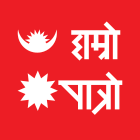Upcomming Events
-
21MangsirInternational Civil Aviation Day tomorrow
-
22MangsirInternational Dignified Menstruation Day 2 days remaning
-
23MangsirInternational Anti-corruption Day 3 days remaning
-
24MangsirInternational Human Rights Day 4 days remaning
-
25MangsirInternational Mountain Day 5 days remaning
-
26MangsirGorakhkali Puja/International Day of Neutrality 6 days remaning
-
29MangsirSafala Ekadashi Vrata 9 days remaning
-
1PaushDhanu Sankranti 10 days remaning
-
2PaushPradosh Vrata 11 days remaning
-
3PaushInternational Immigrants Day 12 days remaning
-
5PaushTol Lhosar 14 days remaning
-
6PaushWorld Meditation Day 15 days remaning
-
10PaushChristmas 19 days remaning
-
13PaushGorakhkali Puja 22 days remaning
-
15PaushTamu Lhosar/Kavi Siromani Lekhnath Jayanti/Putrada Ekadashi Vrata 24 days remaning
-
17PaushNew Year 2026/Pradosh Vrata/Topi Day/Poshak Day 26 days remaning
-
19PaushSri Swasthani Vrata Katha Prarambha/Maagh Snan/Poornima Vrata 28 days remaning
-
21PaushGuru Gobinda Singh Jayanti 30 days remaning
-
23PaushAraniko Smriti Day 32 days remaning
-
24PaushNepal Astrology Council Establishment Day 33 days remaning
-
27PaushPrithivi Jayanti/Rashtriya Ekata Diwas/Gorakhkali Puja 36 days remaning
-
29PaushNational Bhakka Day 38 days remaning
-
30PaushShattila Ekadashi 39 days remaning
-
1MaghMakar Sankranti/Ghiu chaku khane Din/Uttarayan Arambha 40 days remaning
-
2MaghNational Earthquake Safety Day/Pradosh Vrata 41 days remaning
-
5MaghSonam Lhochhar/Shree Ballav Jayanti 44 days remaning
-
8MaghTilkunda Chauthi 47 days remaning
-
9MaghBasanta Panchami vrata/Saraswati Pooja 48 days remaning
-
10MaghSkanda Sasti/Achala Saptami/International Day of Education 49 days remaning
-
11MaghGorakhkali Puja/World Leprosy Day 50 days remaning
-
12MaghInternational Custom Day 51 days remaning
-
13MaghDron Nawami 52 days remaning
-
15MaghBhima Ekadashi Vrata 54 days remaning
-
16MaghSahid Diwas/Pradosh Vrata 55 days remaning
-
18MaghShree Swasthani Brata Samapti/Poornima Wrata 57 days remaning
-
19MaghWorld Wetlands Day 58 days remaning
-
21MaghWorld Cancer Day 60 days remaning
-
25MaghRavisaptami Vrata 64 days remaning
-
26MaghGorakhkali Puja 65 days remaning
-
28MaghInternational Day of Women and Girls in Science/Safer Internet Day 67 days remaning
Jyotish
-
Jyotish Pandit Mukunda Nepalज्योतिष पण्डित मुकुन्द नेपाल�...
-
Jyotish Purushottam Ghimireनेपाल संस्कृत विश्वविद्यालय, �...
-
Jyotish Dipendra Khatiwadaसम्पुर्णानन्द संस्कृत बिश्वब...
-
Jyotish Mohan Ghimireसम्पुर्णानन्द संस्कृत विश्वव...
-
Jyotish Smarika Acharyaबाल्मीकि बिद्यापिठ बाट ज्योत�...
-
Jyotish Narayan Prasad Gautamगुरुकुल शिक्षा प्रणालीबाट ज्�...
-
Jyotish Damodar Poudelनेपाल संस्कृत विश्व बिद्यालय�...
-
Jyotish Vaman Sapkotaशिक्षा - व्याकरणाचार्य, पौरोही...
-
 Jyotish Dharmendra Krishna Paudelशास्त्री धर्मेन्द्र कृष्ण पौ�...
Jyotish Dharmendra Krishna Paudelशास्त्री धर्मेन्द्र कृष्ण पौ�...
-
Jyotish Amrit Paudelवाराणसीकै सम्पूर्णानन्द संस्...
-
Jyotish Narayan Prasad Bhandariज्योतिषका उप-प्राध्यापक (lecturer of A...
-
 Jyotish Mukunda Sharmaस्वाध्याय, सत्सङ्ग र सदाचारजस�...
Jyotish Mukunda Sharmaस्वाध्याय, सत्सङ्ग र सदाचारजस�...
-
 Jyotish Kuresh Pandey११ वर्षको अनुभवसहित विभिन्न ध�...
Jyotish Kuresh Pandey११ वर्षको अनुभवसहित विभिन्न ध�...
-
Jyotish Krishna Prasad Bhandariउपप्राध्यापक (Asst. professor of Sanskrit) नेपा�...
-
Jyotish Deepak Prasad Kafleसम्पूर्णानन्द संस्कृत विश्वव...
-
Jyotish Damodar Kaushikज्योतिष र व्याकरण विषयमा आचार�...
-
Jyotish Khageshwor Subediगुरुकुल पद्दति बाट ज्योतिषीय �...
-
Jyotish Ghanashyam Pokharelनेपाल संस्कृत विश्वविद्यालयब...
-
Acharya Choodamani Pathakसम्पूर्णानन्दसंस्कृत विश्वव�...
-
Jyotish Dr. Janak Bhattaविगत ३५ वर्षदेखि कुण्डली निर्�...
-
Jyotish Khagendra Subediसम्पूर्णानंद संस्कृत विश्ववि...
call
MY NOTE
Upcomming Events
-
21MangsirInternational Civil Aviation Day tomorrow
-
22MangsirInternational Dignified Menstruation Day 2 days remaning
-
23MangsirInternational Anti-corruption Day 3 days remaning
-
24MangsirInternational Human Rights Day 4 days remaning
-
25MangsirInternational Mountain Day 5 days remaning
-
26MangsirGorakhkali Puja/International Day of Neutrality 6 days remaning
-
29MangsirSafala Ekadashi Vrata 9 days remaning
-
1PaushDhanu Sankranti 10 days remaning
-
2PaushPradosh Vrata 11 days remaning
-
3PaushInternational Immigrants Day 12 days remaning
-
5PaushTol Lhosar 14 days remaning
-
6PaushWorld Meditation Day 15 days remaning
-
10PaushChristmas 19 days remaning
-
13PaushGorakhkali Puja 22 days remaning
-
15PaushTamu Lhosar/Kavi Siromani Lekhnath Jayanti/Putrada Ekadashi Vrata 24 days remaning
-
17PaushNew Year 2026/Pradosh Vrata/Topi Day/Poshak Day 26 days remaning
-
19PaushSri Swasthani Vrata Katha Prarambha/Maagh Snan/Poornima Vrata 28 days remaning
-
21PaushGuru Gobinda Singh Jayanti 30 days remaning
-
23PaushAraniko Smriti Day 32 days remaning
-
24PaushNepal Astrology Council Establishment Day 33 days remaning
-
27PaushPrithivi Jayanti/Rashtriya Ekata Diwas/Gorakhkali Puja 36 days remaning
-
29PaushNational Bhakka Day 38 days remaning
-
30PaushShattila Ekadashi 39 days remaning
-
1MaghMakar Sankranti/Ghiu chaku khane Din/Uttarayan Arambha 40 days remaning
-
2MaghNational Earthquake Safety Day/Pradosh Vrata 41 days remaning
-
5MaghSonam Lhochhar/Shree Ballav Jayanti 44 days remaning
-
8MaghTilkunda Chauthi 47 days remaning
-
9MaghBasanta Panchami vrata/Saraswati Pooja 48 days remaning
-
10MaghSkanda Sasti/Achala Saptami/International Day of Education 49 days remaning
-
11MaghGorakhkali Puja/World Leprosy Day 50 days remaning
-
12MaghInternational Custom Day 51 days remaning
-
13MaghDron Nawami 52 days remaning
-
15MaghBhima Ekadashi Vrata 54 days remaning
-
16MaghSahid Diwas/Pradosh Vrata 55 days remaning
-
18MaghShree Swasthani Brata Samapti/Poornima Wrata 57 days remaning
-
19MaghWorld Wetlands Day 58 days remaning
-
21MaghWorld Cancer Day 60 days remaning
-
25MaghRavisaptami Vrata 64 days remaning
-
26MaghGorakhkali Puja 65 days remaning
-
28MaghInternational Day of Women and Girls in Science/Safer Internet Day 67 days remaning
Jyotish
-
Jyotish Pandit Mukunda Nepalज्योतिष पण्डित मुकुन्द नेपाल�...
-
Jyotish Purushottam Ghimireनेपाल संस्कृत विश्वविद्यालय, �...
-
Jyotish Dipendra Khatiwadaसम्पुर्णानन्द संस्कृत बिश्वब...
-
Jyotish Mohan Ghimireसम्पुर्णानन्द संस्कृत विश्वव...
-
Jyotish Smarika Acharyaबाल्मीकि बिद्यापिठ बाट ज्योत�...
-
Jyotish Narayan Prasad Gautamगुरुकुल शिक्षा प्रणालीबाट ज्�...
-
Jyotish Damodar Poudelनेपाल संस्कृत विश्व बिद्यालय�...
-
Jyotish Vaman Sapkotaशिक्षा - व्याकरणाचार्य, पौरोही...
-
 Jyotish Dharmendra Krishna Paudelशास्त्री धर्मेन्द्र कृष्ण पौ�...
Jyotish Dharmendra Krishna Paudelशास्त्री धर्मेन्द्र कृष्ण पौ�...
-
Jyotish Amrit Paudelवाराणसीकै सम्पूर्णानन्द संस्...
-
Jyotish Narayan Prasad Bhandariज्योतिषका उप-प्राध्यापक (lecturer of A...
-
 Jyotish Mukunda Sharmaस्वाध्याय, सत्सङ्ग र सदाचारजस�...
Jyotish Mukunda Sharmaस्वाध्याय, सत्सङ्ग र सदाचारजस�...
-
 Jyotish Kuresh Pandey११ वर्षको अनुभवसहित विभिन्न ध�...
Jyotish Kuresh Pandey११ वर्षको अनुभवसहित विभिन्न ध�...
-
Jyotish Krishna Prasad Bhandariउपप्राध्यापक (Asst. professor of Sanskrit) नेपा�...
-
Jyotish Deepak Prasad Kafleसम्पूर्णानन्द संस्कृत विश्वव...
-
Jyotish Damodar Kaushikज्योतिष र व्याकरण विषयमा आचार�...
-
Jyotish Khageshwor Subediगुरुकुल पद्दति बाट ज्योतिषीय �...
-
Jyotish Ghanashyam Pokharelनेपाल संस्कृत विश्वविद्यालयब...
-
Acharya Choodamani Pathakसम्पूर्णानन्दसंस्कृत विश्वव�...
-
Jyotish Dr. Janak Bhattaविगत ३५ वर्षदेखि कुण्डली निर्�...
-
Jyotish Khagendra Subediसम्पूर्णानंद संस्कृत विश्ववि...
call
Liked by:




















 Mesh
Mesh Brish
Brish Mithun
Mithun Karkat
Karkat  Singha
Singha  Kanya
Kanya Tula
Tula Brischik
Brischik Dhanu
Dhanu  Makar
Makar  Kumbha
Kumbha Meen
Meen